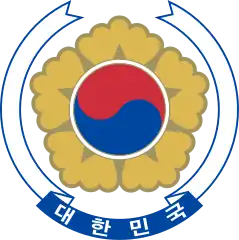Democratic Justice Party
The Democratic Justice Party (Korean: 민주정의당; Hanja: 民主正義黨; RR: Minjujeonguidang; MR: Minjuchŏngŭidang; DJP) was the ruling party of South Korea from 1981 to 1988.
Democratic Justice Party 민주정의당 民主正義黨 | |
|---|---|
| Leader | Roh Tae-woo (1985–1990) |
| Founder | Chun Doo-hwan |
| Founded | 15 January 1981 |
| Dissolved | 22 January 1990 |
| Merged into | Democratic Liberal |
| Headquarters | Seoul, South Korea |
| Ideology |
|
| Political position |
|
| National affiliation | Hanahoe |
| Colours | |
| Party flag | |
 | |
| Democratic Justice Party | |
| Hangul | 민주정의당 |
|---|---|
| Hanja | 民主正義黨 |
| Revised Romanization | Minjujeonguidang |
| McCune–Reischauer | Minjuchŏngŭidang |
| DJP | |
| Hangul | 민정당 |
| Hanja | 民正黨 |
| Revised Romanization | Minjeongdang |
| McCune–Reischauer | Minjŏngdang |
| Part of a series on |
| Conservatism in South Korea |
|---|
 |
History
Chun had become the country's de facto leader after leading a military coup in December 1979, and was elected president in his own right in August 1980. Two months after taking office, he abolished all political parties, including Park Chung Hee's Democratic Republican Party, which had ruled the country since 1963, and with few viable constraints on its power since Park's self-coup of 1971. A new Constitution, which inaugurated the Fifth Republic, was enacted later in October.
The following January, Chun created the Democratic Justice Party, which garnered the support of most DRP lawmakers and politicians; for all intents and purposes it was the DRP under a new name. He was elected as the first president of the Fifth Republic in 1981. Although the DJP won large majorities at legislative elections in 1981 and 1985 and the system was heavily rigged in its favor, it had far less power than the DRP.
The 1980 Constitution limited the president to a single seven-year term, with no possibility of reelection. Chun announced his retirement in 1987, but resisted all calls to further open up the regime. The situation changed later in 1987, when DJP presidential candidate Roh Tae-woo promised that year's presidential election would be free and democratic. Roh became the first direct elected president under free and fair election in December 1987. In 1990, the DJP merged with Kim Young-Sam's Reunification Democratic Party and Kim Jong-pil's New Democratic Republican Party to form the Democratic Liberal Party.
Election results
President
| Election | Candidate | Votes | % | Result |
|---|---|---|---|---|
| 1981 | Chun Doo-hwan | 4,755 | 90.23 | Elected |
| 1987 | Roh Tae-woo | 8,282,738 | 36.64 | Elected |
Legislature
| Election | Leader | Votes | % | Seats | Position | Status | |||
|---|---|---|---|---|---|---|---|---|---|
| Constituency | Party list | Total | +/– | ||||||
| 1981 | Chun Doo-hwan | 5,776,624 | 35.64 | 90 / 184 |
61 / 92 |
151 / 276 |
new | 1st | Government |
| 1985 | 7,040,811 | 35.25 | 87 / 184 |
61 / 92 |
148 / 276 |
Government | |||
| 1988 | Roh Tae-woo | 6,675,494 | 33.96 | 87 / 224 |
38 / 75 |
125 / 299 |
Government | ||
Notes
References
- Kim, Youngmi (2011), The Politics of Coalition in Korea: Between institutions and culture, Routledge, p. 36
- 韓國言論 100年史, 한국 언론인 연합회 (Federation of Korean Reporter) (until 1987), 2006, p. 176